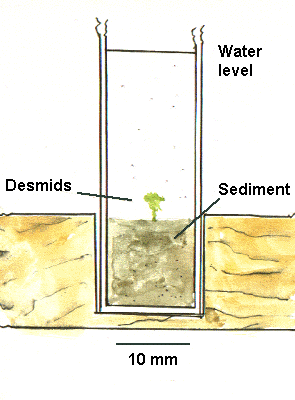ON THE MOVEMENT OF
DESMIDS
William Ells
Coniferae, Walnut Tree Lane, Loose, Maidstone, Kent. ME15 9RG.
Tel. (01622) 744819
 Unable to travel as much as I would like, I rely on
friends to provide me with samples. Anne Bruce sends me samples
collected by her husband Alastair. These samples are usually in
tubes about 100mm x 15mm, because they are easily knocked over I
have drilled holes slightly larger than the diameter of the tubes
into a block of wood about 15mm thick to stand them in.
Unable to travel as much as I would like, I rely on
friends to provide me with samples. Anne Bruce sends me samples
collected by her husband Alastair. These samples are usually in
tubes about 100mm x 15mm, because they are easily knocked over I
have drilled holes slightly larger than the diameter of the tubes
into a block of wood about 15mm thick to stand them in.
The last batch to arrive consisted of three
tubes, I was able to examine the contents of two of the tubes the
day they arrived, for reasons I will not bore you with the third
tube was not examined until it had stood on my north facing
window sill for 48 hours. When I had a look at this sample there
was a sediment in the bottom just below the level of the hole in
the wood block, on top of this sediment there was what looked
like a little green tree 2 - 2.5mm. high. This was carefully
taken up with a pipette and placed on a slide, the 'tree' was
entirely made up of hundreds of desmids, 12 genera and 27
different species were counted. I have found these little 'trees'
before, but they have always consisted of many cells of a single
species of the genus Closterium.
Desmids excrete and clothe themselves with
mucilage, a transparent slimy substance. Some species in copious
amounts that can be seen without staining or differential
contrast under an optical microscope. With others it is a thinner
substance that only shows up when Indian ink or stain is added to
the water (photo's of this have been shown in earlier articles).
Desmids are able to move by extruding mucilage
from an apex and moving in the opposite direction - jet propelled
! They are also able to attach themselves to the substrate and to
each other. Moving towards the light, sticking together with
mucilage, and probably still multiplying by division a 'growth'
visible to the unaided eye occurs, made up of desmids that cannot
be seen individually without magnification.
Later another 12 species were recorded that did
not occur in the 'tree'.
The author gives grateful thanks to Anne and
Alastair for this excellent sample from Scotland.
Editor's note: Comments and
feedback via email to Bill Ells welcomed.
© Microscopy UK or their
contributors.
First published in Micscape Magazine,
September 1997 ( ISSN 1365 - 070x )
Article archived at
http://www.microscopy-uk.net/mag/art97b/desmove.html
Please report any Web problems
or offer general comments to the Micscape Editor,
via the contact on current Micscape Index.
Micscape is the on-line monthly
magazine of the Microscopy UK web
site at Microscopy-UK
WIDTH=1
© Onview.net Ltd, Microscopy-UK, and all contributors 1995 onwards. All rights
reserved. Main site is at www.microscopy-uk.org.uk with full mirror at www.microscopy-uk.net.
 Unable to travel as much as I would like, I rely on
friends to provide me with samples. Anne Bruce sends me samples
collected by her husband Alastair. These samples are usually in
tubes about 100mm x 15mm, because they are easily knocked over I
have drilled holes slightly larger than the diameter of the tubes
into a block of wood about 15mm thick to stand them in.
Unable to travel as much as I would like, I rely on
friends to provide me with samples. Anne Bruce sends me samples
collected by her husband Alastair. These samples are usually in
tubes about 100mm x 15mm, because they are easily knocked over I
have drilled holes slightly larger than the diameter of the tubes
into a block of wood about 15mm thick to stand them in.